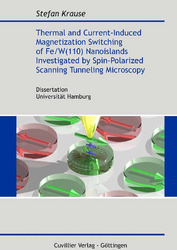| Departments | |
|---|---|
| Book Series (96) |
1379
|
| Nachhaltigkeit |
3
|
| Gesundheitswesen |
1
|
| Humanities |
2367
|
| Natural Sciences |
5407
|
| Mathematics | 229 |
| Informatics | 319 |
| Physics | 980 |
| Chemistry | 1364 |
| Geosciences | 131 |
| Human medicine | 243 |
| Stomatology | 10 |
| Veterinary medicine | 108 |
| Pharmacy | 147 |
| Biology | 835 |
| Biochemistry, molecular biology, gene technology | 121 |
| Biophysics | 25 |
| Domestic and nutritional science | 45 |
| Agricultural science | 1004 |
| Forest science | 201 |
| Horticultural science | 20 |
| Environmental research, ecology and landscape conservation | 148 |
| Engineering |
1793
|
| Common |
98
|
|
Leitlinien Unfallchirurgie
5. Auflage bestellen |
|
Advanced Search
Thermal and Current-Induced Magnetization Switching of Fe/W(110) Nanoislands Investigated by Spin-Polarized Scanning Tunneling Microscopy (English shop)
Stefan Krause (Author)Preview
Table of Contents, Datei (51 KB)
Extract, Datei (150 KB)
Future high-density magnetic data storage demands both, a detailed understanding of the magnetic reversal processes as well as basic concepts of local magnetization switching, for instance by the injection of a spin-polarized current. Spin-polarized tunneling microscopy (SP-STM) is a powerful tool to investigate surface magnetism on the atomic scale, providing a fascinating insight to the world at the transition from classical to quantum physics.
Within this work the thermal magnetization switching behavior of individual Fe/W(110) nanoislands is observed using SP-STM at variable temperature. The experiments reveal that even for very small Fe/W(110) nanoislands, consisting of less than hundred atoms, magnetization reversal takes place via the nucleation and diffusion of a domain wall rather than by a coherent rotation of all magnetic moments. Moreover, SP-STM can not only observe but simultaneously influence magnetism: For the first time it is demonstrated that an SP-STM probe tip also serves as a tool to manipulate the magnetic state of a nanoisland. Combining current-induced magnetization reversal across a vacuum barrier and the ultimate resolution of SP-STM enables the separation and unique quantification of the three fundamental contributions involved in magnetization switching, i.e. pure spin torque, Joule heating, and Oersted field effects. At low temperature the magnetization of the nanoislands becomes quasistable. However, magnetization reversal is triggered using high tunnel current pulses generated by the probe tip.
These results open new perspectives for future magnetic data storage applications without any magnetic field, as read and write processes are solely based on spin-polarized currents. The experiments provide an improved understanding of the microscopic magnetization switching mechanisms and may stimulate a variety of future investigations in this exciting field of physics.
| ISBN-13 (Printausgabe) | 3869550341 |
| ISBN-13 (Hard Copy) | 9783869550343 |
| ISBN-13 (eBook) | 9783736930346 |
| Language | English |
| Page Number | 106 |
| Edition | 1 Aufl. |
| Volume | 0 |
| Publication Place | Göttingen |
| Place of Dissertation | Universität Hamburg |
| Publication Date | 2009-07-09 |
| General Categorization | Dissertation |
| Departments |
Physics
|








